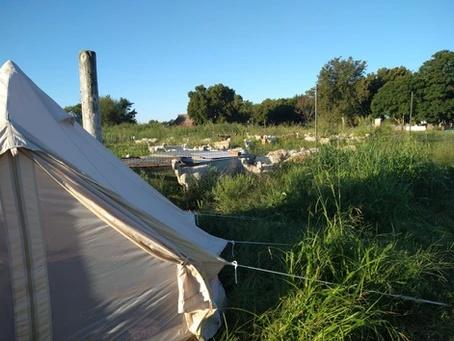Fuller Field School

By Jeffery Heppler
“Back in 2012, long before soil health, regenerative agriculture or carbon farming became cool, farmer Gail Fuller and soil scientist Dr. Jill Clapperton invited a fringe group of farmers, researchers, and community leaders to share ideas, innovate, and build relationships. This informal gathering of renegades came to be known as ‘Fuller Field School.'” – fullerfieldschool.com
We pulled into Circle 7 Fuller Farms near dusk. I had little idea what was in store other than a good potluck that evening. I walk into a barn that has been renovated into a commercial kitchen and dining space. A dozen folks or so were seated, passing food and drinks around. I decided to bring around the cookies I had brought as a means to introduce myself. After some more drinks and conversation in lawn chairs outside on the comfortable September night, I went off to pitch my tent by headlamp.
The next morning was an early one. Sleep did not come easily, so the shower and coffee were welcome to get my wits about me. There was morning dew on the ground as we settled on the lawn for the first talk to begin.
Nicole Masters was first up. She is an independent agroecologist, systems thinker, storyteller, and educator as introduced by the Fuller Field School. Her mission is to achieve soil health by finding the spark that ignites soil biology. She does this by going through the five Ms with her clients. They are mindset, management, minerals, microbes, and organic matter. Her book, For the Love of Soil, further explains how to better soil through case studies of her adventures from New Zealand and Australia to the U.S. and Canada.
The first step is to test the soil to see what is present or absent. A simple deficiency or over-concentration can bind up the whole system. Another first step is to dig a hole. Investigate the rhizosheath of plant roots. Are they “Rastafarian Roots”, that look like dreadlocks covered in clinging aggregates with many root hairs, or are they bare roots with few hairs? A healthy rhizosheath provides plant protection, acts as a pH buffer, maximizes yield, and encourages drought resistance. A healthy seed and root microbiome result from a well-balanced soil. What does the soil smell like? What soil life is visible? What plant species are present? Pigweed, thistle, nettle, and nightshade for example are indicator species that point to potential nitrate buildup. These are all clues to assess soil health.
Land managers must ask, “Who/what am I farming for? What impact will this decision have?”. Every act of disturbance pushes a system back in ecological succession, towards bacteria-dominated soils. These soils tend to run off and have high evaporation rates. This is where sprawlers, taproots, and annual grasses (weeds) thrive the most. Fungi-dominated soils have larger aggregates, which means more space for air and water.
We were shown a trick with a refractometer (a tool used to measure the sugar content of plant matter) whereby looking at the Brix reading of different plant species in a given area we can see which species is more competitive. If it is a desirable species, then we are on the right track. The higher the Brix, the healthier the plant because it means it is more efficiently turning sunlight into sugars for itself and the soil microbiome.
Next up was Sara Keough MS, CNS, LDN an Eco-Nutritionist who investigates how food choices impact the health of people and the planet. She talked about the rise of inflammation and immune dysfunction; how this is caused by the damaging of our microbiome through our diet, sedentary lifestyle, chronic environmental stress, agricultural practices, medical practices, and now excessive hygiene and social isolation. Our health is determined so much by how and what we eat because the immune system needs these inputs. There are far more microbes on and in our body than there are human cells (the cells that contain our DNA). Our cells and the microbiome work together to go on living. We are an ecosystem.
Much like soil testing, the gut can and should also be tested for imbalances. There is a litany of tests that may be taken. There are advanced lipid panels, stool tests, tests for hormones, omega 3 and 6, and mold and fungi. These tests can be expensive, but like soil, a single deficiency or overconcentration of something can disrupt the entire system.
For a more DIY approach, Sara recommends starting with the stomach, making sure that enough stomach acid (bile) is being produced. Bile breaks down fats and turns fiber into short-chain fatty acids for the body. Increased production can be encouraged by staying hydrated, eating bitter foods, and certain teas like dandelion root and licorice. L-glutamine found in bone broths is good for immune support by providing much-needed nitrogen and carbon to cells of the body and reducing inflammation especially during stressful times.
If an individual is suffering from symptoms of digestive issues, like leaky gut (where there is a literal hole in your intestine causing inflammation), it may be necessary to start from scratch as it were. Taking an antibiotic and reseeding the gut with beneficial microbes from fermented foods and other probiotics may be the solution, aptly called ‘weeding and seeding.’
The last point on restoring gut health is to expose oneself to different and more natural environments, picking up microbes from these places, breathing the fresh air that also contains microbes, fungal spores, and more. If we are not getting out, then bringing plants and other things from the outside in.
So, what does a healthy diet according to an Eco-Nutritionist look like? There are four principles she outlined. The first is eating as many whole foods as possible. Second, choose the best quality available that you can afford. Third, diversify as much as possible. Try to get as many colors, textures, and flavors as possible (especially bitter!). Lastly, including more fermented and wild foods. These are gut microbiome superchargers full of beneficials, but also potential pathogens that are good practice for our ever-evolving immune systems.
Lunch was served by Chi Em Eats out of Emporia, KS. My words won’t do it justice, but it was delicious Vietnamese cuisine! I remember succulent chicken, duck pate, and a fresh cucumber salad. I will make a point to stop there next time I am in the neighborhood.
For the afternoon, there were a series of breakout field sessions. We checked in first with Lynette Miller, Gail’s wife, who runs the sheep on the farm. She showed us her process for breaking down and putting up electric netted fencing. Next, we went to a nearby hole excavated 4-5′ deep by a machine where Nicole was examining the soil and sharing her observations. The last stop was with Sara where we sampled some ferments, bitters, and apple cider vinegar tonics to jump-start our gut health.
Dinner was served by Chef Gerard Rodriguez out of Wichita, KS. He served a phenomenal spread of Mexican BBQ fusion which included smoked and braised pork, borracho beans, and traditional tacos served with all the fixings. This was the best meal of the event in my opinion. No doubt, it was a taste of his restaurant Adios Nachoria at Wave, but I’ll have to visit to be sure. Chef Gerard also operates Cool Breeze Pizza in Riverside and R Coffee House.
Just as we finished eating, we were able to watch a lovely sunset from our picnic table. I was fortunate enough to go on a short walk at dusk with Nicole and a couple of young farmers. We talked about the landscape, our different contexts, and challenges. We neared the bottom of the hill, where the chickens were residing in their livestock trailer coops. The livestock guardian was posing for the camera dutifully at his post. There were automatic solar-powered doors on these coops! I snapped some photos for reference and we all peered into the coops and wondered why some chickens seemed to prefer one trailer over the other. Dusk was finishing as we walked back up and parted ways for the evening.
The next morning, I was much better rested, but by the end of the first round of talks and a hearty lunch, folks were feeling sluggish. This was remedied by a role-play of interactions in the soil followed by an interactive panel discussion where Sara and Nicole explored the intersectionality of their fields. I have tried to recreate those ties here, but there is so much to explore.
This experience allowed me to meet so many like-minded people from all walks of life. I met folks in business consulting and marketing, from the Kansas foster care system, composting industry, small and large hold farmers, soil entrepreneurs, and the list goes on. These connections may grow into collaboration. Collaborations bring about change. Perhaps I’ll see some of them next year.

